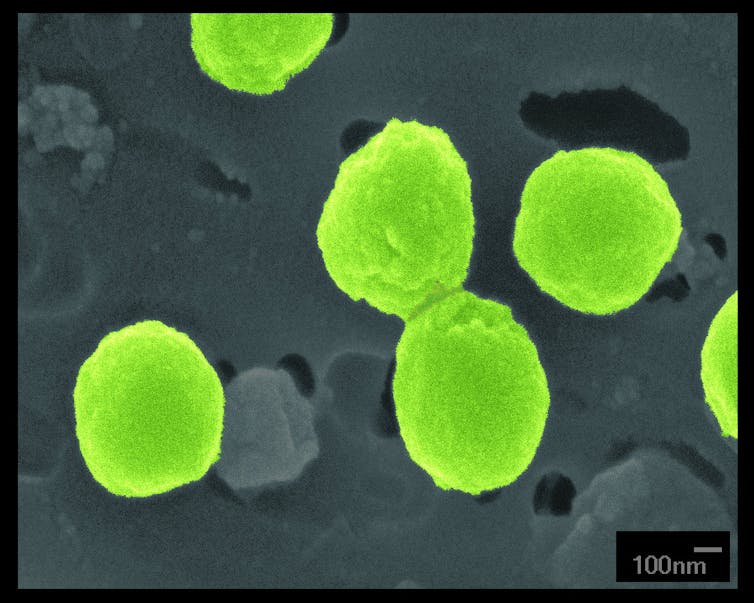Many viral genetic sequences code for proteins that researchers haven’t seen before.
Libusha Kelly, Albert Einstein College of Medicine
Viruses are a mysterious and poorly understood force in microbial ecosystems. Researchers know they can infect, kill and manipulate human and bacterial cells in nearly every environment, from the oceans to your gut. But scientists don’t yet have a full picture of how viruses affect their surrounding environments in large part because of their extraordinary diversity and ability to rapidly evolve.
Communities of microbes are difficult to study in a laboratory setting. Many microbes are challenging to cultivate, and their natural environment has many more features influencing their success or failure than scientists can replicate in a lab.
So systems biologists like me often sequence all the DNA present in a sample – for example, a fecal sample from a patient – separate out the viral DNA sequences, then annotate the sections of the viral genome that code for proteins. These notes on the location, structure and other features of genes help researchers understand the functions viruses might carry out in the environment and help identify different kinds of viruses. Researchers annotate viruses by matching viral sequences in a sample to previously annotated sequences available in public databases of viral genetic sequences.
However, scientists are identifying viral sequences in DNA collected from the environment at a rate that far outpaces our ability to annotate those genes. This means researchers are publishing findings about viruses in microbial ecosystems using unacceptably small fractions of available data.
To improve researchers’ ability to study viruses around the globe, my team and I have developed a novel approach to annotate viral sequences using artificial intelligence. Through protein language models akin to large language models like ChatGPT but specific to proteins, we were able to classify previously unseen viral sequences. This opens the door for researchers to not only learn more about viruses, but also to address biological questions that are difficult to answer with current techniques.
Annotating viruses with AI
Large language models use relationships between words in large datasets of text to provide potential answers to questions they are not explicitly “taught” the answer to. When you ask a chatbot “What is the capital of France?” for example, the model is not looking up the answer in a table of capital cities. Rather, it is using its training on huge datasets of documents and information to infer the answer: “The capital of France is Paris.”
Similarly, protein language models are AI algorithms that are trained to recognize relationships between billions of protein sequences from environments around the world. Through this training, they may be able to infer something about the essence of viral proteins and their functions.
We wondered whether protein language models could answer this question: “Given all annotated viral genetic sequences, what is this new sequence’s function?”
In our proof of concept, we trained neural networks on previously annotated viral protein sequences in pre-trained protein language models and then used them to predict the annotation of new viral protein sequences. Our approach allows us to probe what the model is “seeing” in a particular viral sequence that leads to a particular annotation. This helps identify candidate proteins of interest either based on their specific functions or how their genome is arranged, winnowing down the search space of vast datasets.
Prochlorococcus is one of the many species of marine bacteria with proteins that researchers haven’t seen before.
By identifying more distantly related viral gene functions, protein language models can complement current methods to provide new insights into microbiology. For example, my team and I were able to use our model to discover a previously unrecognized integrase – a type of protein that can move genetic information in and out of cells – in the globally abundant marine picocyanobacteria Prochlorococcus and Synechococcus. Notably, this integrase may be able to move genes in and out of these populations of bacteria in the oceans and enable these microbes to better adapt to changing environments.
Our language model also identified a novel viral capsid protein that is widespread in the global oceans. We produced the first picture of how its genes are arranged, showing it can contain different sets of genes that we believe indicates this virus serves different functions in its environment.
These preliminary findings represent only two of thousands of annotations our approach has provided.
Analyzing the unknown
Most of the hundreds of thousands of newly discovered viruses remain unclassified. Many viral genetic sequences match protein families with no known function or have never been seen before. Our work shows that similar protein language models could help study the threat and promise of our planet’s many uncharacterized viruses.
While our study focused on viruses in the global oceans, improved annotation of viral proteins is critical for better understanding the role viruses play in health and disease in the human body. We and other researchers have hypothesized that viral activity in the human gut microbiome might be altered when you’re sick. This means that viruses may help identify stress in microbial communities.
However, our approach is also limited because it requires high-quality annotations. Researchers are developing newer protein language models that incorporate other “tasks” as part of their training, particularly predicting protein structures to detect similar proteins, to make them more powerful.
Making all AI tools available via FAIR Data Principles – data that is findable, accessible, interoperable and reusable – can help researchers at large realize the potential of these new ways of annotating protein sequences leading to discoveries that benefit human health.![]()
Libusha Kelly, Associate Professor of Systems and Computational Biology, Microbiology and Immunology, Albert Einstein College of Medicine
This article is republished from The Conversation under a Creative Commons license. Read the original article.

























































